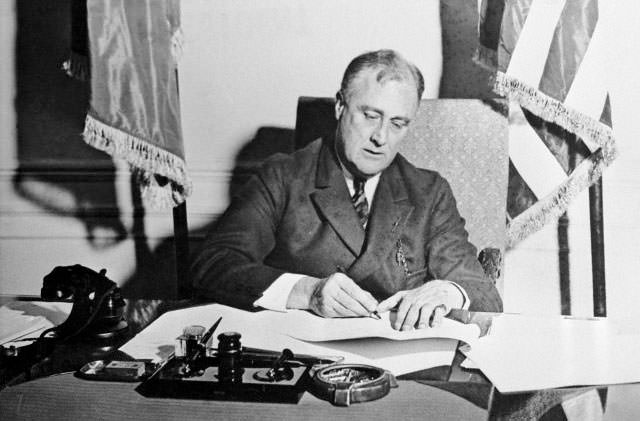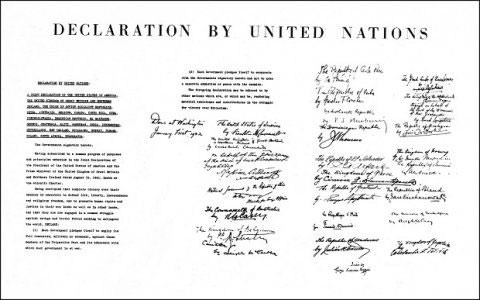Franklin Delano Roosevelt is often rated by scholars as among the top three U.S. Presidents along with Abraham Lincoln and George Washington. He was the longest serving president in the history of United States winning a record four presidential elections and serving from 1933 to 1945. Roosevelt came into office at the lowest point in the country’s worst ever depression and countered it through his program for relief, recovery and reform, famous as the New Deal. He then led America through World War II, playing an instrumental role in the defeat of the Axis Powers. Know why FDR is considered one of the greatest presidents by studying his 10 major accomplishments; and also get informed about his role in World War II.
#1 HE SERVED AS GOVERNOR OF NEW YORK
Franklin D. Roosevelt was elected governor of New York in 1928 and served from 1 January 1929 until his election as President of U.S. in 1932. As governor of NY, Roosevelt tackled official corruption, addressed the city’s need for power through the development of hydroelectricity on the St. Lawrence River, reformed the state’s prison administration and built a new state prison at Attica. When the nation was struck by the Great Depression, America’s worst financial crisis, Roosevelt set up the Temporary Emergency Relief Administration (TERA), which aimed at finding jobs for the unemployed. By 1932, TERA was helping nearly one out of every 10 families in New York

#2 FDR IS THE LONGEST SERVING PRESIDENT IN THE HISTORY OF UNITED STATES
In the 1932 presidential election, Franklin D. Roosevelt defeated incumbent Republican president Herbert Hoover to become the 32nd President of the United States. He was re-elected in a landslide victory in 1936. In 1940, FDR ran for a third term against the convention of a maximum two terms which had been established by first US president George Washington. Roosevelt again won by a huge margin. He also won the 1944 election and thus served as the President of the United States from 1933 till his death on April 12, 1945. The two term convention was made into a law after Roosevelt. FDR remains the longest serving US President.
#3 HE ARRESTED FINANCIAL PANIC THROUGH THE EMERGENCY BANKING ACT
When Roosevelt was inaugurated as U.S. President on March 4, 1933, the country was at the lowest point of its worst ever depression. He began the momentous first 100 days of his presidency by closing all banks for several days until Congress could pass reform legislation. The Emergency Banking Act was introduced on March 9, 1933. It allowed the twelve Federal Reserve Banks to issue additional currency on good assets. Depositors returned their stashed cash to neighborhood banks and on March 15, 1933, the New York Stock Exchange recorded the largest one-day percentage price increase ever. The Emergency Banking Act brought stability and ended the bank runs that had plagued the Great Depression.

#4 THE FDIC WAS ESTABLISHED THROUGH THE 1933 BANKING ACT
The temporary Emergency Banking Act was followed by the 1933 Banking Act, also known as the Glass–Steagall Act. Signed into law by Roosevelt on June 16, 1933, it established the Federal Deposit Insurance Corporation (FDIC). FDIC provided deposit insurance, which protects bank depositors from losses caused by a bank’s inability to pay its debts when due. It restored the trust in the American banking system and is functional till date. The Glass–Steagall Act also separated commercial and investment banking.

#5 He SET UP MANY IMPORTANT INSTITUTIONS AS PART OF HIS FIRST NEW DEAL
FDR is famous for a series of domestic programs he enacted in U.S. between 1933 and 1938 that are known as the New Deal. In the first New Deal, Roosevelt set up in 1933 the Federal Emergency Relief Administration (FERA), which gave grants and loans to states to operate relief programs; the Civilian Conservation Corps (CCC), which in 9 years employed 3 million young men in manual labor jobs related to conservation and development of natural resources; the Agricultural Adjustment Administration (AAA), which by 1935 increased the income generated by farms by 50% by paying farmers subsidies to reduce crop production; the Public Works Administration (PWA), which spent over $6 billion to built large-scale public works and drove America’s biggest construction effort up to that date; and the Tennessee Valley Authority (TVA), which provided power, controlled floods and modernized agriculture in the Tennessee Valley, a region particularly affected by the depression.

#6 SOCIAL SECURITY SYSTEM WAS CREATED DURING HIS PRESIDENCY
In the 1935-36 Second New Deal of Roosevelt, the Work Projects Administration (WPA) was established which employed millions of unemployed people to carry out public works projects; the Social Security Act was enacted to provide economic security for the elderly, the poor and the sick; and the National Labor Relations Act was signed into law to guarantee the basic rights of private sector employees like organizing into trade unions. During Franklin D. Roosevelt’s first term unemployment fell dramatically from 25% to 14.3% and by the end of his presidency it had fell to 1.9% due to World War II. The economy grew 58% from 1932 to 1940 in 8 years of peacetime, and then grew 56% from 1940 to 1945 in 5 years of wartime.

#7 HE ESTABLISHED A NATIONAL MINIMUM WAGE
Major legislation passed during the second term of FDR included the Housing Act of 1937 which provided subsidies to local public housing agencies to improve living conditions for low-income families; and the Fair Labor Standards Act of 1938 which introduced the forty-hour work week, established a national minimum wage, guaranteed 1.5 times the hourly rate for overtime in certain jobs and prohibited most employment of minors in oppressive child labor.

#8 HE TOOK THE FIRST FEDERAL ACTION TO PROHIBIT EMPLOYMENT DISCRIMINATION
Franklin D. Roosevelt was a hero to major minority groups, especially African Americans, Catholics, and Jews. The Indian Reorganization Act of 1934 was passed to provide ways for Native Americans to re-establish sovereignty and self-government; and to achieve economic self-sufficiency. On June 25, 1941, Executive Order 8802 was signed by Roosevelt creating the Fair Employment Practice Committee (FEPC) to prohibit racial and religious discrimination in the national defense industry. This was the first national program directed against employment discrimination. Also New Deal institutions like WPA and CCC provided an economic alternative to agriculture and domestic service for the entire black community.

#9 FDR CO-LED THE ALLIED COALITION TO VICTORY IN WW2
In response to the advent of World War II in September 1939, Roosevelt initially adopted the twin policies of preparedness through measures like re-armament and “all aid short of war” to the Allied coalition. Japanese attack on Pearl Harbor on December 7, 1941 led to Roosevelt calling for war in his famous “Infamy Speech” and within an hour, Congress passed formal declaration of war against Japan. On December 11, Germany and Italy declared war on U.S. and U.S. responded in kind. Along with Winston Churchill of Britain and Joseph Stalin of the Soviet Union, FDR formed the ‘Big Three’ of the Allied Coalition, who were instrumental in implementing a war strategy that ended in the defeat of Axis Powers.

#10 HE PLAYED A MAJOR ROLE IN THE CREATION OF THE UNITED NATIONS
During the Second World War, Roosevelt first coined the term United Nations to describe the Allied countries and initiated talks on a successor agency to the League of Nations to prevent another major conflict. Along with Churchill and Harry Hopkins, FDR drafted the Declaration by the United Nations. The document was agreed upon by 26 governments on 1st January 1942 during the Arcadia Conference and was the basis of the modern UN. Franklin D. Roosevelt died on April 12, 1945, just a few months before the end of World War II. The UN Charter was signed on 26 June 1945 and it began operation on 24 October 1945.

FDR IN THE SECOND WORLD WAR
PRE – PEARL HARBOR
During the initial stage of World War II, Roosevelt made America the “Arsenal of Democracy”. Through the Lend-Lease policy, US supplied the Allied nations food, oil, material and weaponry including warships and warplanes; totaling $50.1 billion (equivalent to $659 billion today). Through Executive Order 8807, Roosevelt created the Office of Scientific Research and Development (OSRD) to coordinate scientific research for military purposes during the war. OSRD would later develop the first atomic bombs. Along with Churchill, Roosevelt drafted the Atlantic Charter which defined the war goals of the Allied nations; like it rejected territorial aspirations and promoted autonomous governments. It was issued as a joint declaration on 14 August 1941 and was later endorsed by all Allied nations.

Post – Pearl Harbor
After Pearl Harbor, Roosevelt became one of the leading figures in the Allied coalition. He helped in formation of an informal alliance between U.S., Britain, China and the Soviet Union to co-ordinate the Allied war effort. Roosevelt met Churchill, and at times Stalin, in a series of conferences leading to vital decisions. Like the Quebec Conference in 1943 included discussions on initiating Operation Overlord, the Allied operation that would launch the successful invasion of German-occupied Western Europe; and on accelerating efforts of U.S., Britain and Canada to develop an atomic bomb. FDR thus helped strategize the Allied victory. Several historians credit FDR for transforming America from an isolationist nation to the leader in world affairs through his pivotal role in World War II.


look at all these comments getting all worked up about politics. im just here for my english class.
who was his vice president
John Nance Garner (1933 to 1941)
Henry Agard Wallace (1941 to 1945)
Harry S. Truman (1945)
Hope that helps.
The democratic party of FDR is nothing like the democratic party of today who strives only to kill and destroy. #Trump2024
Haahaahaahaa. Yeah, and trump was such a great guy. Right? Always told the truth, worked hard with no time off to golf, was always true to his wife, wanted the shoot people in the legs one day to stop them from assembling peacefully. Yeah. Such a sweet heart he was. But tell me again, what exactly did he do for the country??? I must have missed it. I was sick one day and that must have been the day he did something worthwhile, like stay in the office and work and shut the Fow news and TV off for the day.
T-G ;
Well Pres. Accomplished a lot :
Pres. Trump also accomplished a Lot ,
But differently ; Drain the Swamp partially at way ;
True Patriotism is hard to define Today ; Caution the Fruit on the
Tree !! The Dems are killing this country!
FDR was not only the greatest leader in American history,and while Washington and Lincoln’s achievements also, stand out, there is no comparison to both FDR’s domestic and foreign policy impact on not just the U.S., but on the world!
FDR is this context should be viewed as one of history’s greatest and impactful leaders.